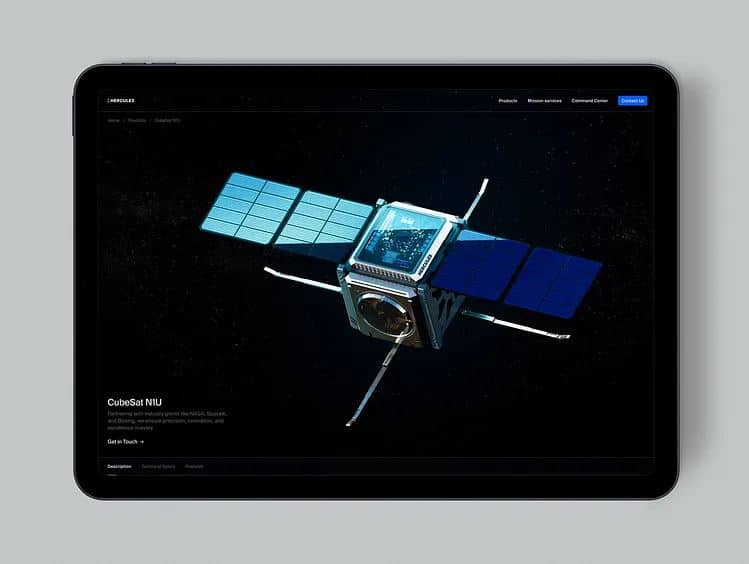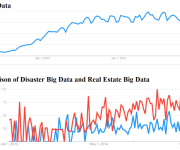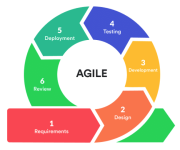Building Digital Trust: Why Web Development Is Now a Brand Strategy
In 2025, consumers no longer separate a brand’s identity from its digital presence. A clunky website, a slow-loading app, or an insecure checkout experience isn’t viewed as just a technical flaw – it is interpreted as a failure of the brand itself. For modern businesses, web development has become synonymous with brand strategy.
Website Design for Satellite Control & Launch Platform designed by Shakuro
Digital trust has emerged as the new currency of loyalty. Customers reward brands that consistently deliver seamless, secure, and human-centered digital experiences. They don’t just purchase products or services; they develop long-term relationships with brands that prove themselves reliable in the digital space. This is why businesses that invest in high-performance, secure, and intuitive platforms, including iOS app development, often see compounding returns in retention, advocacy, and lifetime customer value.
The Evolution of Trust in the Digital Era
Traditionally, brand trust was built through advertising campaigns, personal recommendations, and the quality of customer service. While these factors still matter, the digital interface has now become the frontline of reputation. For many customers, their first – and sometimes only – interaction with a brand happens online. The smoothness, security, and responsiveness of that interaction directly translate into credibility and perceived value.
Key Shifts Driving This Change
- Always-on expectations. Customers expect flawless, round-the-clock availability. Downtime, lag, or glitches don’t just frustrate users; they create doubts about whether the business can be trusted to deliver consistently.
- Privacy concerns. In a world of rising cyber threats and frequent breaches, the way a company handles user data has become a cornerstone of trust. Transparency in data handling, secure infrastructure, and compliance with privacy laws are now non-negotiable.
- Experience-first competition. Users benchmark every digital experience against global leaders like Amazon, Apple, and Airbnb. Even if a business operates in a completely different industry, customers expect the same level of ease, personalization, and intuitive design.
- Global reach. The internet gives brands worldwide exposure, but it also means that a single poor digital experience can instantly impact perception across multiple markets. What was once a local complaint can now ripple globally in real time.
Insight: Trust is no longer just an emotional outcome of advertising and service. It has become a technical, experiential, and infrastructural reality, deeply rooted in the quality of a brand’s web development.
Why Web Development = Brand Strategy
Strong brands in 2025 no longer treat their websites as static marketing collateral. Instead, they view them as living, breathing trust engines – platforms that continuously shape perception, build credibility, and influence every customer interaction. In an environment where digital presence defines brand equity, the technical backbone of a site is inseparable from the trust customers place in the brand.
The Direct Link Between Development and Trust
Performance as Credibility
- Fast load times signal reliability. They are a signal of reliability and credibility. When a website responds instantly, users perceive the brand as competent, well-managed, and capable of delivering on promises. Conversely, delays or lag create friction and doubt, undermining confidence in the company’s ability to meet customer expectations, fulfill orders, or provide support. In 2025, where user patience is measured in milliseconds, speed directly correlates with trust and engagement.
- Optimized mobile experiences convey professionalism. Convey professionalism and attention to user needs. With mobile-first audiences dominating the digital landscape, a seamless experience across smartphones, tablets, and other devices demonstrates that a brand prioritizes accessibility and adheres to modern digital standards. Mobile optimization is no longer optional; it signals that the company understands user behavior, embraces innovation, and values every touchpoint of the customer journey.
Security as Reputation
- Customers equate breaches with negligence. In the digital-first world of 2025, even a single leak or security incident can permanently damage trust, signaling that the brand is careless with sensitive information. The consequences go beyond lost sales – reputational harm can hinder customer acquisition, retention, and even investor confidence, making security a core business priority rather than a technical afterthought.
- Proactive protection builds confidence. Brands that clearly communicate their use of encryption, robust authentication protocols, and compliance with privacy regulations demonstrate a commitment to safeguarding customer data. By embedding security into every layer of their digital platform, companies reassure users that sensitive transactions are handled with the utmost care, reinforcing trust and encouraging long-term engagement.
UX as Emotional Trust
- Clear navigation reduces friction. When visitors can effortlessly locate the information, products, or features they need, they experience a sense of control and clarity. This ease of use not only improves engagement but also signals that the brand respects its customers’ time and understands their needs, fostering a subtle yet powerful layer of trust.
- Thoughtful micro-interactions humanize digital journeys. These small, purposeful touches – such as subtle animations, confirmation messages, or context-sensitive guidance – transform routine actions into engaging moments. By providing immediate feedback and making interactions feel responsive and personalized, micro-interactions enhance user satisfaction, deepen emotional connection with the brand, and make the digital journey feel more natural and approachable.
Consistency as Integrity
- Unified design and functionality reinforce reliability. A brand that feels the same across desktop, mobile, and apps signals stability and organizational discipline. Customers subconsciously associate this consistency with integrity.

Portfolio Website Design, Marketing Website, Web Design designed by Shakuro
The Role of Custom Web Development in Building Trust
While off-the-shelf solutions can get a business online quickly, they often restrict how much trust a brand can project. Templates limit differentiation, scale poorly under pressure, and expose businesses to shared vulnerabilities. By contrast, custom web development gives companies full control over their digital reputation, ensuring that trust is engineered into every detail rather than added as an afterthought.
Advantages of a Tailored Approach
- Scalable infrastructure. Custom builds allow a digital environment to grow seamlessly as traffic increases and new features are introduced, ensuring that performance and reliability are never compromised during periods of rapid expansion. This scalability supports both short-term marketing campaigns and long-term business growth, providing a foundation that can adapt to evolving demands.
- Personalized experiences. A tailored system enables brands to align every digital interaction with customer expectations, delivering relevant content, recommendations, and functionality at scale. By offering experiences that feel unique to each user, companies can differentiate themselves from competitors and foster deeper engagement and loyalty.
- Advanced security measures. Encryption, secure authentication, and proactive compliance monitoring protect sensitive user data and safeguard the brand’s reputation. Unlike generic solutions, a custom approach allows security to be embedded into the architecture rather than added as an afterthought, minimizing vulnerabilities and building trust with customers.
- Seamless integrations. By connecting CRMs, analytics tools, customer support platforms, and automation systems into a unified ecosystem, businesses create transparency and consistency across all touchpoints. This interconnected environment not only streamlines operations but also reinforces user confidence, as customers experience smooth, predictable, and reliable interactions across every channel.
Partnering with a custom web development company in USA ensures that trust is not simply a byproduct of design but a principle woven into the very architecture of the platform.
Trust by Design: Best Practices for 2025
In today’s hyper-competitive digital economy, trust isn’t a “soft” factor – it’s a measurable driver of growth. Forward-thinking brands recognize that trust must be engineered directly into their digital platforms through deliberate choices in architecture, workflows, and governance. By embedding trust into the very DNA of development, businesses ensure that every interaction reinforces credibility, reliability, and user confidence.
Practical Steps for Executives and Teams
Adopt a security-first mindset
- In 2025, security is no longer optional – it is a foundational expectation. Every digital platform should be engineered with encryption, multi-factor authentication, and regulatory compliance embedded from the outset rather than added as an afterthought. By building security into the architecture, companies reduce the risk of breaches, protect sensitive user data, and prevent costly operational disruptions.
- Executives should reframe cybersecurity investment as a brand-building activity, not merely a risk-management cost. Demonstrating that a company takes security seriously sends a powerful signal of reliability and trustworthiness to customers, investors, and partners alike.
Prioritize accessibility
- Inclusive design goes beyond regulatory compliance – it is a reflection of a company’s integrity and commitment to all users. Implementing features such as screen reader compatibility, intuitive keyboard navigation, and high-contrast visual elements ensures that digital platforms are usable by people with diverse abilities.
- Accessibility also expands market reach, allowing more users to engage meaningfully with the brand. By embedding accessibility into the core design process, companies reinforce ethical positioning, foster trust, and demonstrate that user experience is valued as much as functionality or aesthetics.
Build modular systems
- Modular architecture is a cornerstone of agile, resilient web platforms. By separating core functionality from individual features, companies can introduce updates, fix vulnerabilities, or scale components independently, without disrupting the overall user experience.
- This flexibility not only reduces downtime and operational risk but also allows for faster iteration in response to user feedback or market changes. For customers, a platform that consistently works smoothly and adapts to their needs signals that the brand is both innovative and reliable – two essential pillars of digital trust in 2025.
Leverage data ethically
- Transparent and responsible data practices are increasingly critical in shaping customer perception. Platforms should clearly request consent, provide accessible privacy settings, and communicate how data is collected, stored, and used.
- Ethical data handling reassures users that their information is respected and protected, fostering long-term loyalty and engagement. In an era where privacy scandals can quickly erode credibility, companies that demonstrate integrity in their data practices gain a competitive advantage, reinforcing trust while strengthening their brand reputation.
Test relentlessly
- Continuous performance, load, and UX testing catch potential trust-breaking failures before they reach the customer.
- A culture of testing ensures that users experience the brand at its best every time, reinforcing dependability.
Case Example: Trust as a Growth Driver
A direct-to-consumer (DTC) health brand experienced firsthand how fragile digital infrastructure can erode trust and business performance.
Challenge
The company initially relied on a template-based e-commerce platform. During peak sales campaigns, the site repeatedly crashed, leading to lost transactions, frustrated customers, and a surge in refund requests. These failures didn’t just affect immediate revenue – they damaged the brand’s credibility, creating long-term trust issues with both customers and investors.
Solution
To address these challenges, the brand partnered with a custom web development agency to build a scalable and secure platform. The new system incorporated advanced security protocols, robust load balancing, and modular architecture designed to handle high traffic volumes while supporting future growth and feature expansion.
Outcome
The upgraded platform dramatically improved operational stability and user experience. Downtime was reduced by 95%, repeat customer rates increased by 28%, and investor confidence strengthened during subsequent fundraising rounds.
Lesson
This case demonstrates that trust is far more than a soft metric – it directly influences revenue, customer retention, and company valuation. By designing digital platforms with trust at the core, organizations turn their web infrastructure from a potential liability into a strategic engine for sustainable growth.
Why CEOs and CMOs Must Care
For executives, the stakes are high. Digital trust has become a key competitive differentiator, directly influencing business outcomes beyond immediate sales. A reliable, secure, and seamless digital experience shapes how customers perceive a brand – and that perception extends into strategic areas of the business.
Investor perception: Strong digital infrastructure signals operational maturity, stability, and forward-thinking leadership. Investors recognize that platforms designed with scalability, security, and user experience in mind reduce risk and support long-term growth.
Talent recruitment: Tech-savvy professionals are increasingly selective about their employers. Brands that demonstrate innovation, reliability, and attention to digital trust attract top talent eager to contribute to high-performing, respected organizations.
Global expansion: Entering new markets – especially regulated regions – requires platforms that comply with local data protection laws and performance standards. Trustworthy, compliant systems smooth regulatory hurdles and reduce friction for international growth.
Conclusion
In 2025, digital trust is inseparable from brand equity. Every millisecond of load time, every secure login, and every frictionless checkout shapes how customers view your company. Treating web development as a strategic component of brand building ensures that trust is embedded in every interaction, decision, and digital process.
The question for executives has shifted. It is no longer simply, “Do we need a better website?” Instead, it is, “How do we embed trust into every line of code, every interface, and every user journey?” Companies that answer this question proactively will not only earn customer loyalty – they will generate measurable growth, operational resilience, and a distinct market advantage.
























